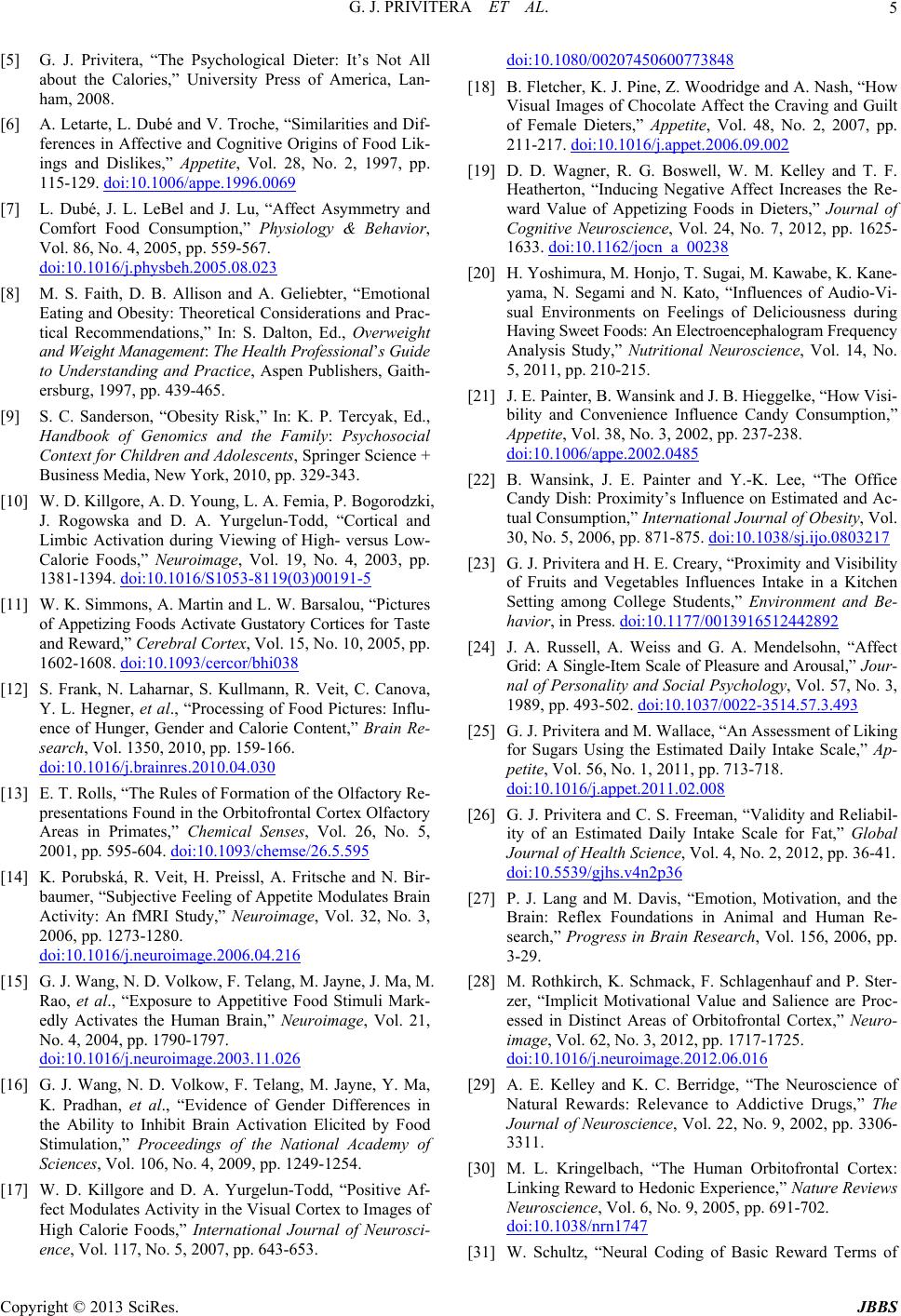
G. J. PRIVITERA ET AL. 5
[5] G. J. Privitera, “The Psychological Dieter: It’s Not All
about the Calories,” University Press of America, Lan-
ham, 2008.
[6] A. Letarte, L. Dubé and V. Troche, “Similarities and Dif-
ferences in Affective and Cognitive Origins of Food Lik-
ings and Dislikes,” Appetite, Vol. 28, No. 2, 1997, pp.
115-129. doi:10.1006/appe.1996.0069
[7] L. Dubé, J. L. LeBel and J. Lu, “Affect Asymmetry and
Comfort Food Consumption,” Physiology & Behavior,
Vol. 86, No. 4, 2005, pp. 559-567.
doi:10.1016/j.physbeh.2005.08.023
[8] M. S. Faith, D. B. Allison and A. Geliebter, “Emotional
Eating and Obesity: Theoretical Considerations and Prac-
tical Recommendations,” In: S. Dalton, Ed., Overweight
and Weight Management: The Health Professional’s Gu i d e
to Understanding and Practice, Aspen Publishers, Gaith-
ersburg, 1997, pp. 439-465.
[9] S. C. Sanderson, “Obesity Risk,” In: K. P. Tercyak, Ed.,
Handbook of Genomics and the Family: Psychosocial
Context for Children and Adolescents, Springer Science +
Business Media, New York, 2010, pp. 329-343.
[10] W. D. Killgore, A. D. Young, L. A. Femia, P. Bogorodzki,
J. Rogowska and D. A. Yurgelun-Todd, “Cortical and
Limbic Activation during Viewing of High- versus Low-
Calorie Foods,” Neuroimage, Vol. 19, No. 4, 2003, pp.
1381-1394. doi:10.1016/S1053-8119(03)00191-5
[11] W. K. Simmons, A. Martin and L. W. Barsalou, “Pictures
of Appetizing Foods Activate Gustatory Cortices for Taste
and Reward,” Cerebral Cortex, Vol. 15, No. 10, 2005, pp.
1602-1608. doi:10.1093/cercor/bhi038
[12] S. Frank, N. Laharnar, S. Kullmann, R. Veit, C. Canova,
Y. L. Hegner, et al., “Processing of Food Pictures: Influ-
ence of Hunger, Gender and Calorie Content,” Brain Re-
search, Vol. 1350, 2010, pp. 159-166.
doi:10.1016/j.brainres.2010.04.030
[13] E. T. Rolls, “The Rules of Formation of the Olfactory Re-
presentations Found in the Orbitofrontal Cortex Olfactory
Areas in Primates,” Chemical Senses, Vol. 26, No. 5,
2001, pp. 595-604. doi:10.1093/chemse/26.5.595
[14] K. Porubská, R. Veit, H. Preissl, A. Fritsche and N. Bir-
baumer, “Subjective Feeling of Appetite Modulates Brain
Activity: An fMRI Study,” Neuroimage, Vol. 32, No. 3,
2006, pp. 1273-1280.
doi:10.1016/j.neuroimage.2006.04.216
[15] G. J. Wang, N. D. Volkow, F. Telang, M. Jayne, J. Ma, M.
Rao, et al., “Exposure to Appetitive Food Stimuli Mark-
edly Activates the Human Brain,” Neuroimage, Vol. 21,
No. 4, 2004, pp. 1790-1797.
doi:10.1016/j.neuroimage.2003.11.026
[16] G. J. Wang, N. D. Volkow, F. Telang, M. Jayne, Y. Ma,
K. Pradhan, et al., “Evidence of Gender Differences in
the Ability to Inhibit Brain Activation Elicited by Food
Stimulation,” Proceedings of the National Academy of
Sciences, Vol. 106, No. 4, 2009, pp. 1249-1254.
[17] W. D. Killgore and D. A. Yurgelun-Todd, “Positive Af-
fect Modulates Activity in the Visual Cortex to Images of
High Calorie Foods,” International Journal of Neurosci-
ence, Vol. 117, No. 5, 2007, pp. 643-653.
doi:10.1080/00207450600773848
[18] B. Fletcher, K. J. Pine, Z. Woodridge and A. Nash, “How
Visual Images of Chocolate Affect the Craving and Guilt
of Female Dieters,” Appetite , Vol. 48, No. 2, 2007, pp.
211-217. doi:10.1016/j.appet.2006.09.002
[19] D. D. Wagner, R. G. Boswell, W. M. Kelley and T. F.
Heatherton, “Inducing Negative Affect Increases the Re-
ward Value of Appetizing Foods in Dieters,” Journal of
Cognitive Neuroscience, Vol. 24, No. 7, 2012, pp. 1625-
1633. doi:10.1162/jocn_a_00238
[20] H. Yoshimura, M. Honjo, T. Sugai, M. Kawabe, K. Kane-
yama, N. Segami and N. Kato, “Influences of Audio-Vi-
sual Environments on Feelings of Deliciousness during
Having Sweet Foods: An Electroencephalogram Frequency
Analysis Study,” Nutritional Neuroscience, Vol. 14, No.
5, 2011, pp. 210-215.
[21] J. E. Painter, B. Wansink and J. B. Hieggelke, “How Visi-
bility and Convenience Influence Candy Consumption,”
Appetite, Vol. 38, No. 3, 2002, pp. 237-238.
doi:10.1006/appe.2002.0485
[22] B. Wansink, J. E. Painter and Y.-K. Lee, “The Office
Candy Dish: Proximity’s Influence on Estimated and Ac-
tual Consumption,” International Journal of Obesity, Vol.
30, No. 5, 2006, pp. 871-875. doi:10.1038/sj.ijo.0803217
[23] G. J. Privitera and H. E. Creary, “Proximity and Visibility
of Fruits and Vegetables Influences Intake in a Kitchen
Setting among College Students,” Environment and Be-
havior, in Press. doi:10.1177/0013916512442892
[24] J. A. Russell, A. Weiss and G. A. Mendelsohn, “Affect
Grid: A Single-Item Scale of Pleasure and Arousal,” Jour-
nal of Personality and Social Psychology, Vol. 57, No. 3,
1989, pp. 493-502. doi:10.1037/0022-3514.57.3.493
[25] G. J. Privitera and M. Wallace, “An Assessment of Liking
for Sugars Using the Estimated Daily Intake Scale,” Ap-
petite, Vol. 56, No. 1, 2011, pp. 713-718.
doi:10.1016/j.appet.2011.02.008
[26] G. J. Privitera and C. S. Freeman, “Validity and Reliabil-
ity of an Estimated Daily Intake Scale for Fat,” Global
Journal of Health Science, Vol. 4, No. 2, 2012, pp. 36-41.
doi:10.5539/gjhs.v4n2p36
[27] P. J. Lang and M. Davis, “Emotion, Motivation, and the
Brain: Reflex Foundations in Animal and Human Re-
search,” Progress in Brain Research, Vol. 156, 2006, pp.
3-29.
[28] M. Rothkirch, K. Schmack, F. Schlagenhauf and P. Ster-
zer, “Implicit Motivational Value and Salience are Proc-
essed in Distinct Areas of Orbitofrontal Cortex,” Neuro-
image, Vol. 62, No. 3, 2012, pp. 1717-1725.
doi:10.1016/j.neuroimage.2012.06.016
[29] A. E. Kelley and K. C. Berridge, “The Neuroscience of
Natural Rewards: Relevance to Addictive Drugs,” The
Journal of Neuroscience, Vol. 22, No. 9, 2002, pp. 3306-
3311.
[30] M. L. Kringelbach, “The Human Orbitofrontal Cortex:
Linking Reward to Hedonic Experience,” Nature Reviews
Neuroscience, Vol. 6, No. 9, 2005, pp. 691-702.
doi:10.1038/nrn1747
[31] W. Schultz, “Neural Coding of Basic Reward Terms of
Copyright © 2013 SciRes. JBBS